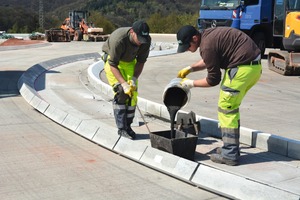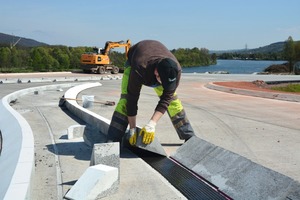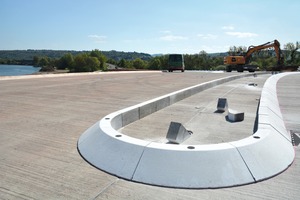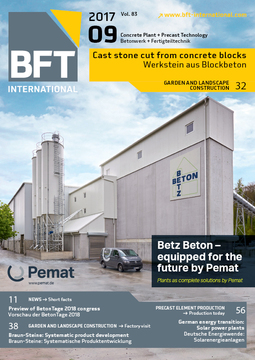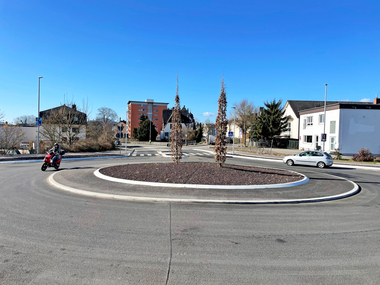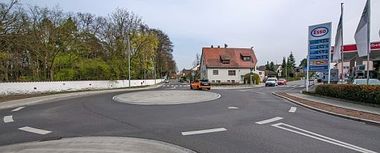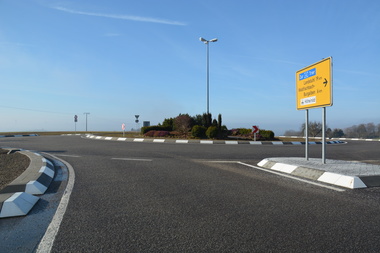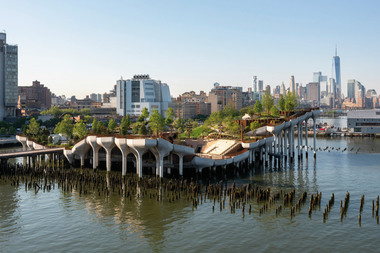Bypass traffic circles with glue-bonded curbstones
The idea of regulating traffic on heavily frequented intersections by circular rather than by linear traffic routing is now more than one hundred years old. At Columbus Circle in New York City, drivers had to travel in a circle to get to the right exit already in 1904. Since then, circular traffic has experienced a meteoric rise. In France, for example, there are currently more than 20,000 “rond-points”.
In Germany, circular traffic has been a common sight for a long time as well. The main reason for the popularity of circular traffic is high throughput speeds compared to signal-controlled intersections or intersections regulated with right-of-way traffic. At heavily frequented circular traffic points, planners nowadays regulate traffic by means of bypasses: separate lanes by means of which traffic is specifically guided around the circle.
Cost-efficient solution for circular traffic
The B 51 is an interstate connecting road. It begins in the Saarland and leads via the Ruhr region all the way to northern Germany. In the vicinity of the city of Trier, it connects the regional center with the surrounding regions of Konz-Saarburg and Bitburg-Prüm. Around Konz-Könen, the traffic volume ranges currently from around 10,000 vehicles per 24 h to as much as approx. 14,000 vehicles per day in the industrial area, with a truck share of more than 10 %. For this reason, planners decided as early as ten years ago to bypass this area. A vital element of the €24-million project, among others, is the link to the existing interstate highway B 419 in form of a large traffic circle.
In view of the high traffic volume, the roadway deck of the traffic circle was constructed of concrete. For the design of the circle and its bypasses, the planners used flat curbstones with Profile FB 30 x 25 (F15) and made by the concrete block manufacturer Betonsteinwerk Meudt in Wallmerod, Germany. The special feature here is that the curbstones were glued onto the prefabricated concrete surface. Dipl.-Ing. (FH) Christof Piskol of the consultancy firm V-KON KG, based in Saarburg, Germany, explained the details of this feature: “For reasons dictated by the technology here, curbstone gluing was the only efficient solution, since this was the only technique for completely prefabricating the concrete road deck in advance – instead of the complex, time-consuming installation of conventional curbstones.”
Excellent traffic
control effect
All the flat curbstones installed here were brought to the exactly identical height of 16 cm by sawing. After lightly milling the concrete deck in the places where the curbstones were to be glued on, a 2-component plastic was applied by application of a thin-bed bonding technique to the concrete slab previously cleaned with a high-pressure water jet. The curbstones were glued at the sawn sides.
Thanks to the many radius elements and shaped blocks that the Meudt production range comprises, the bypasses, the traffic lane dividers, and the roadway edges can be installed practically without cutting. “This saves much time and enables professional execution,” says Piskol.
Good night visibility
with glass markers
An important task of the curbstone edgings around the traffic circle is their traffic controlling effect. The surface faced with white concrete moreover ensures notably improved visibility. In addition, many of the curbstones were fitted with glass markers. “These serve as a supporting measure for enhancing visibility at night and function without electricity,” says Piskol. “With the aid of marker reflection over 360 °, the markers effectively mirror the situation and the volume of traffic in the dark very well – no matter from what traveling direction a driver approaches the traffic circle.”
Curbstone 360 ° markers function based on the same optical principle as the catadioptric reflector. The incident light rays are focused by the dome on the upper side of the glass, then reflected on the inner side and returned to the light source. In this way, the drivers are clearly and in good time alerted to changes in the traffic situation. “Thanks to these highly obvious optical features, we achieve a very good traffic controlling effect with the light-colored curbstones and the glass markers,” explains Piskol. The bypass is scheduled for completion by the end of 2017.

